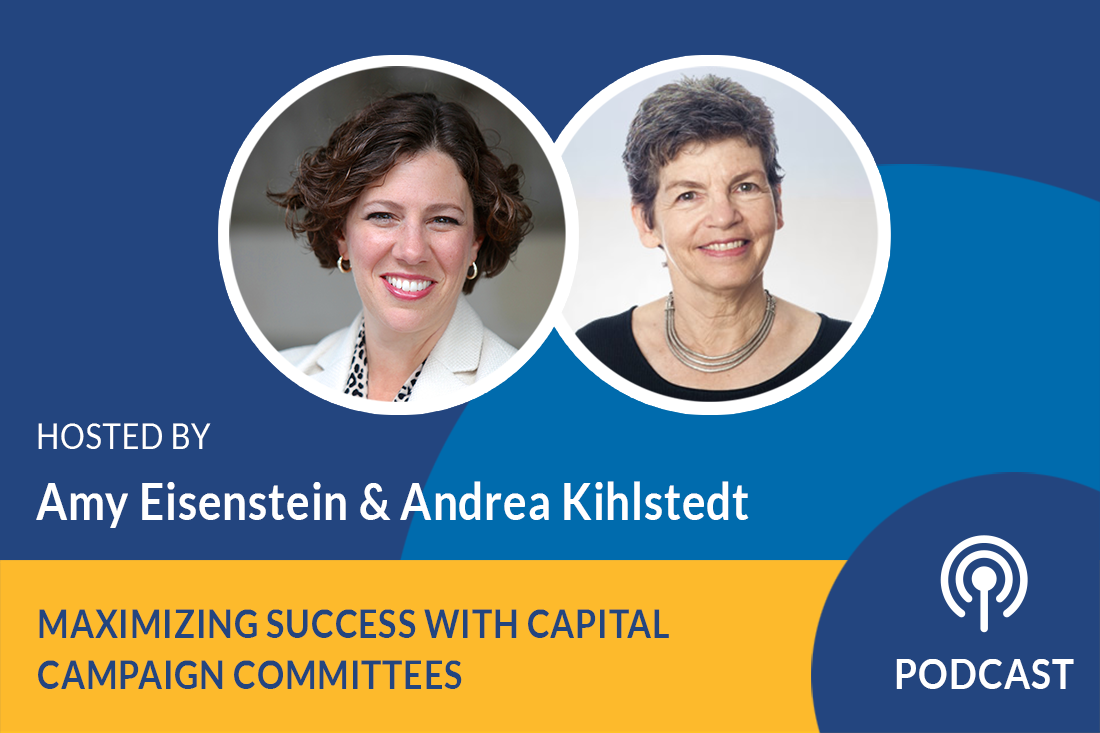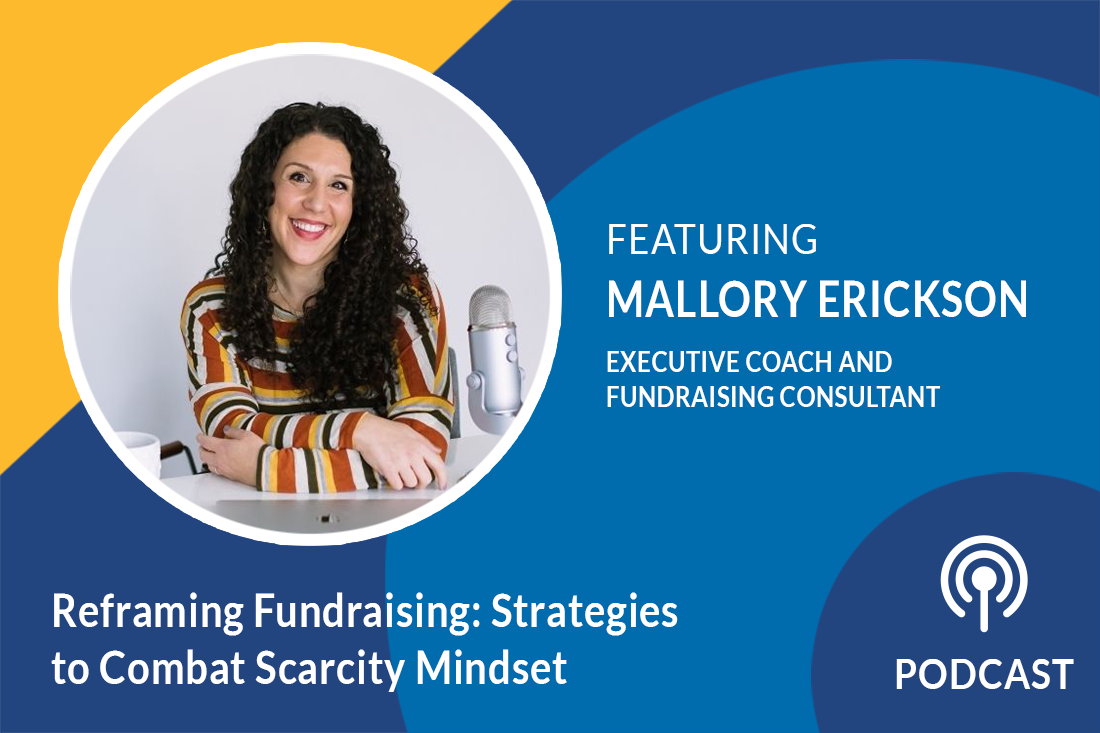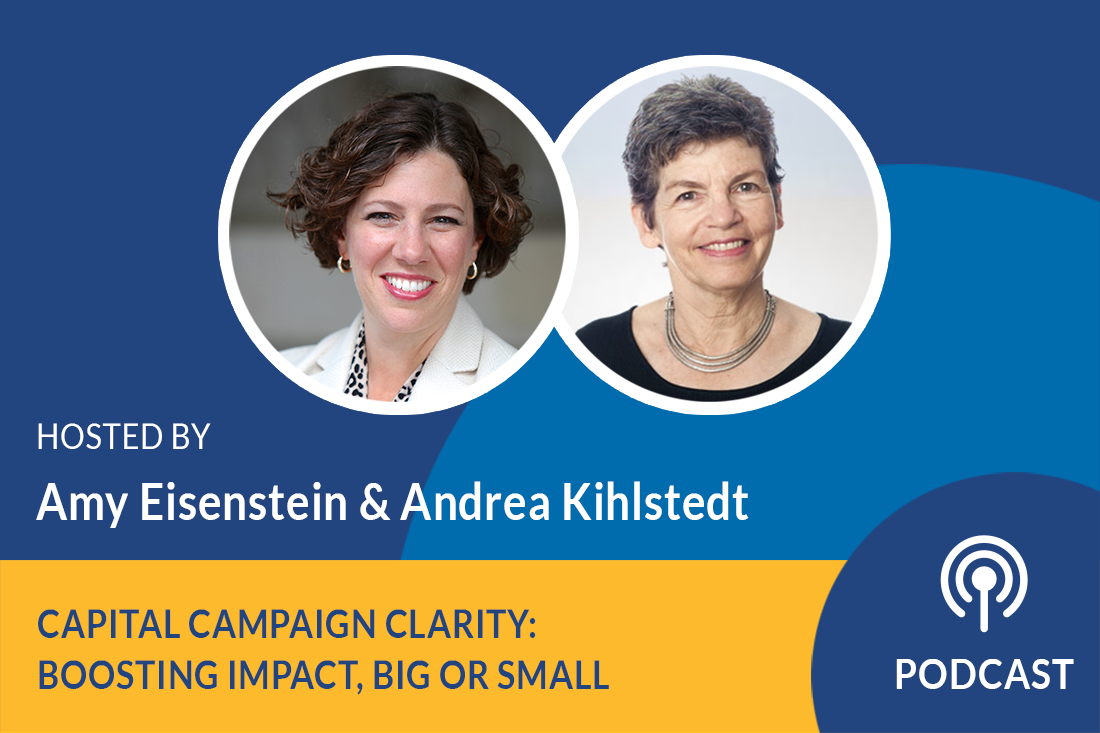Podcast: Maximizing Success with Capital Campaign Committees

Season 3, Episode 33
In this episode, Amy Eisenstein and Andrea Kihlstedt discuss the critical role of campaign committees in your fundraising efforts. They delve into why the traditional long-term campaign committee structure often fails and propose a more effective approach by creating short-term, specialized committees.
Discover how breaking down the campaign into phases and forming committees for specific tasks can help engage and motivate volunteers. Learn about the benefits of ad hoc, or “pop-up,” committees, which allow you to leverage people’s skills and talents in a way that suits their interests and expertise.
Listen Now:
Andrea Kihlstedt:
One of my favorite definitions of capital campaigns is one meeting after another.
Amy Eisenstein:
Hi. I’m Amy Eisenstein, and I’m here with my colleague and co-founder Andrea Kihlstedt. Today we are going to talk about committee meetings and the important role they play in your campaign success. Andrea, get us started with campaign committee meetings.
Andrea Kihlstedt:
Yes, Amy. This is really one of my favorite topics because I think it’s incredibly important, and people don’t think about it or talk about it enough.
When Your Capital Campaign Lacks a Cohesive Committee Structure
Many people, when they do a capital campaign, think that there has to be a campaign committee — one big committee that’s going to go on for a very long time of the duration of your campaign, maybe two years, maybe three years.
Now, when I say that, my eyes start to glaze over, to have a committee that goes on for so long, right? When that happens, when that is the committee structure of a capital campaign, it is almost always unsuccessful. Now, not necessarily the campaign being unsuccessful, but the committee is unsuccessful.
It starts out with maybe you get 18 people to serve on a committee. Maybe for the first three or four meetings you can get everybody to come to those meetings, but then you look around and all of a sudden it’s not 18 people who are there, it’s 12 people. Then a couple months later, you look around and you’re lucky if you get eight people at a meeting.
Committee Members Stop Attending Meetings
There’s a sense of discouragement because people aren’t coming to the meetings. If that continues for the duration of the campaign, it just sucks the energy out of a campaign, so it’s the models. The reason that happens is that the committee model is not right.
Amy Eisenstein:
Right. It ultimately is just a list of names on your letterhead or on your website. That’s how people use the committee. Meetings become just bland, boring, report out sessions. There’s no motivation, or reason really, for committee meetings to show up to hear a bunch of reports. It’s not a good use of their time. It’s not a good use of your time. It’s just a list of names.
That’s not what we want to use campaign committees for. What’s a better model and a better structure?
Involve As Many People In Your Campaign As You Can
Andrea Kihlstedt:
Yeah. Amy, before we talk about a better model and structure, which we will in a second, I just want to remind everybody that it’s very well documented that the more people you have actually involved in a real way in your campaign, the more people will give and give generously, that a significant number of the people who end up giving major gifts and mid-level gifts, and even low level gifts, to your campaign will have been involved as a volunteer in some way throughout the campaign, right?
Having a structure that actually involves people in a way that they’re happy to be involved is important, not just because it helps get the work done, but because that engagement process increases the likelihood of people’s giving, and giving generously. That sets the stage for why we think this is so important.
Amy Eisenstein:
Yes.
A Better Model for Capital Campaign Committees and Meetings
Andrea Kihlstedt:
Now, what kind of a model does work? If you’ve been following us a while, you may know that we think about a campaign in seven phases, starting with pre-campaign planning, then moving into feasibility study, campaign planning, quiet phase kickoff, public phase follow through, or whatever we call the last one.
That’s a very handy and effective way to think about a capital campaign. You can overlay your committee structure on that, because if you think about each of those phases, you realize that you need committees that would do different things in each of the pieces, each of those phases of the campaign.
In the early phase, for example, this pre-campaign planning phase, phase one, you need people who are close to the organization, people who can help you make sure you have clearly articulated what it is you want to raise money for and have come up with the right working goal for your campaign. People who will help you develop a gift range chart and a depth chart, and that list of donors who might make significant contributions, people who can review and give feedback on the preliminary case for support.
These are very important early pieces of campaign planning. You will want to involve some people who know your organization quite well. Being involved in that process will engage them pretty seriously in your campaign. They’re going to understand and know why you’re doing a campaign if they’re engaged at that level.
Committee Members Serve for Shorter Terms
Amy Eisenstein:
Now, the good news about this committee structure and thinking about subcommittees, or ad hoc committees or pop-up committees — whatever you want to call them, is that at the end of this pre-campaign planning work, which may take six months or three months or 12 months, you can thank these committee members. They’ve served on the campaign committee, but they don’t have to commit for three years. They don’t have to commit for the duration of the campaign.
If they are wonderful committees, you can ask them to serve on the next campaign committee for the next phase, which would be the feasibility study committee. If they didn’t show up for meetings or they didn’t follow through, or they didn’t do what they said they were going to do, you can thank them for what they’ve done to date. They can still feel good about their role and you’re not stuck with them for the next three years.
There’s so many benefits actually to thinking about having a series of campaign subcommittees or ad hoc committees along the way for your campaign.
Andrea Kihlstedt:
Yeah. Somebody at one of our Wednesday calls that we do at Capital Campaign Pro, we have Wednesday calls with our members, somebody called them pop-up committees, which I kind of liked, that they come and they go. You start these committees with a very specific piece of work that they’re going to do. You have maybe have two meetings or four meetings, or 12 meetings. It depends on what the role of the objectives of the committee are.
Then you thank them very … When the work is done, you thank them very much and you let them go. You do that. You plan the committees that way so that the people you invite to serve on them understand that they’re not going to be stuck forever, that they aren’t going to have to come to meetings month after month after month, even when the campaign is sort of drudging through that, what is often a complicated draggy period in the middle.
Examples of Different Campaign Committees
Amy Eisenstein:
Right. Let’s give two more examples to compare and contrast the types of people that you might select for your committees. Let’s think about the quiet phase committee, which you might call the leadership gifts committee, and the kickoff committee, which might look more like a party planning committee.
Let’s think through, Andrea, the different types of people that you would want on each of those committees, because they’re very different types of skills and mindsets.
Andrea Kihlstedt:
Yeah, they’re super different, aren’t they? The people you would want on a leadership gifts committee of course are people who will be able and willing to identify people who can make leadership gifts, to cultivate them, and to help solicit them. Those are very specific strengths and skills that people bring to the table. Not everybody can do it. Not everyone is qualified to do it.
Assign Campaign Volunteers According to their Strengths
Maybe you have three or four people, maybe some of them are a couple of board members, maybe a staff member, maybe a former board member who wants to be involved. They will work for a significant period of time actually soliciting the top gifts for your campaign, helping to do that. That’s one kind of a committee.
Now, would those people want to serve on a committee that is picking the napkins for your campaign kickoff, right? Or is hiring the caterer? No, I don’t think so, right?
You know what goes into planning a big event. It is a huge amount of work, and it is a particular kind of expertise that some people really get into. They really know how to do it, they’re great at it. Those are the people that you’re going to want to put on the committee to plan your kickoff.
Amy Eisenstein:
Or your celebration. Right. On the flip side, you don’t want those party planning or event planning volunteers on your leadership gifts committee. That would be ridiculous because they don’t have any interest in doing the big solicitations. They don’t want to necessarily leverage their networks, or maybe they don’t have those networks for the big gift. This ad hoc subcommittee system enables you to really leverage people’s skills and talents where they’re going to be successful. Everybody can feel happy about their role on the campaign.
If you put people on the leadership gifts committee, or you have one massive campaign committee with lots of people who have no business or interest soliciting major gifts, it’s going to be a miserable experience.
This, breaking up these committees, really solves that problem, and so that everybody feels valued and useful and signs up for an appropriate period of time and is not there for all phases of the campaign. I think there’s just so many benefits to this ad hoc committee system.
You’re Never Stuck with Poor Committee Members
Andrea Kihlstedt:
Another thing happens with this committee system because, as Amy said, you can thank and release. As my friend Gail Perry used to say, you can bless and release the people who weren’t very good committee members.
Gradually, as you create new committees, your committees will get better and better because you’re pulling back the people who are really good committee members. As you move through your campaign, your committees are going to function really well, and people who have had a good experience working on one of your committees or another will be happy to be invited back to help you again.
It’s an interesting model and one that … Sometimes people look at our model and they say:
“So many committees. How can we ever manage so many committees?”
But the reality is that it’s much easier to manage committees that are put together for a specific purpose, that have a beginning, a middle, and an end, that they know why they’re there, they know how many meetings they’re going to be invited to come to and participate in.
You get really good at organizing that, so it’s not a lot of work and a lot of effort. It’s just a part of what you do, as opposed to this big unwieldy committee where you see it losing steam and losing energy. You don’t know what to do about it, so you’re spending a ton of time and effort and anxiety trying to figure out how to make that committee work. You’re not getting any of the benefit from actually working with the people who can help you get the work done, which of course these little committees can.
Two Committees You’ll Want for Longer Periods
Amy Eisenstein:
All right, let’s talk about two committees or two groups of people that might be with you for longer periods of time than just for various phases of the campaign.
The Core Committee
The first is your real tight core committee or kitchen cabinet that’s comprised of your executive director, probably your board chair, your development director, and maybe the campaign chair. That tight committee of three, four, or five people does oversee the campaign from start to finish. They’re your core team. We’ve heard it called kitchen cabinet, and they are the brain trust.
Yes. They’re there from the beginning to end, so don’t think that you won’t have a core team of people that are supervising all of these committees and working from the beginning of the campaign through the end of the campaign. There is.
The Steering Committee
There’s also something that we like to talk about, the steering committee, that also is a multi-phase, sort of high-level committee. Why don’t you talk about how you think about something like a steering committee?
Andrea Kihlstedt:
Yeah. The people who serve on various of the small committees should have the opportunity to be informed about the entire campaign. You may put together a campaign steering committee that may meet quarterly, maybe it meets three times a year, maybe even only two times a year.
That’s a fairly large committee. Essentially it’s a reporting committee. It’s a committee that is put together so that different people who are working on various parts of the campaign can come and talk about their work. There can be an overall report of where the campaign is, what the timeline is, how much money the has campaign is raised, what’s next to do.
It actually is a report meeting, but all the people who were involved in these smaller committees have a chance to report on what their group has done.
Amy Eisenstein:
And meet and mingle with the other campaign committees.
Andrea Kihlstedt:
And meet and mingle. Yes, exactly.
Amy Eisenstein:
We might call them the insiders.
Andrea Kihlstedt:
Right, right.
Amy Eisenstein:
I’d like to call them the insiders.
Andrea Kihlstedt:
I like that. I like that idea.
Amy Eisenstein:
They get to know. They’re in the know, right? They’re in the know about what’s happening with the campaign. Even pieces that they’re not directly working on or responsible for, they get the early inside information.
You might go to them with a challenge, when there’s a campaign challenge. You pull all your high-level volunteers together in one room, as Andrea said, two or three times a year to get updates, to deal with a challenge, to be the big brain trust. There’s the little brain trust — the core committee.
Andrea Kihlstedt:
Yeah. Right. That’s right.
Amy Eisenstein:
And the big brain trust.
Primary Benefits of this Multi-Committee Structure
Andrea Kihlstedt:
The other thing you can do, when the campaign crosses its goal, reaches its goal and goes beyond, that’s the first group you’re going to pull together to say:
“Hey, we got over our goal. We’re going to have a party next Friday evening. Join us at such-and-such for an informal celebration.”
You’re going to invite those people because they are insiders, right? That’s not going to be your big campaign celebration. It’s going to be a celebration of the people who really made it happen.
That’s a wonderful way to glue people to your organization, so if you use this model of little committees, little short-term committees, sort of flanked by two longer-term groups, and you get over your fear of that kind of structure, what you’ll find is that by the time the campaign is done, you may have involved 20, 30, 40 people actively in your campaign, and that those people are going to be spreading the word. They themselves are going to be making significant gifts, what for them are significant gifts to your campaign.
They are going to feel loyalty to your campaign and your organization long after the campaign is done. I think it’s a very effective strategy that doesn’t take that much more work. It just takes some clear thinking about how to do this and how to use this kind of structure.
Amy Eisenstein:
Excellent. If listeners want more information or more details, of course our clients have access to our Online Toolkit, which does very clearly outline all of the various committees. We have committee descriptions, job descriptions, and sample agendas available.
If you want to get in touch and learn more about how to access those, visit the capitalcampaignpro.com website. Thanks for tuning in and we’ll see you next time.



Leave a Comment